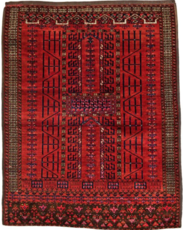Saryk
Sarykly | |
|---|---|
 Drawing of a Saryk man | |
| Regions with significant populations | |
| Marghab Valley (Turkmenistan, Iran, Afghanistan) | |
| Languages | |
| Turkmen (Saryq dialect), Dari | |
| Religion | |
| Sunni Islam | |
| Related ethnic groups | |
| Turkmens, Afghan Turkmens, Iranian Turkmens |
The Saryk (Turkmen: Sarykly) are a tribe of Turkmens in Turkmenistan.[1][2] The Saryk mostly live in the valley of the Marghab River (the ancient Margiana).[3]
Etymology
[edit]Suggestions for the etymology of Saryk (also Sarik, Saryq) are the Middle Turkic saryγ ("yellow") or the Kipchak root saryq ("sheep").[4]
History
[edit]In the early 19th century the Saryk lived in the Merv region, but from 1830 they were driven further up the Marghab valley by the Teke.[5] Bala Murghab and the Panjdeh became their main settlements.[6]
In 1881, the Saryk came under Russian control after the Battle of Geok Tepe and the creation of the Transcaspian Oblast.[7] In 1885, the Saryk population was estimated at 65,000.[6]
They continued under Russian rule through the Soviet period. Today most live in modern Turkmenistan, with some living over the borders in Iran and Afghanistan.[8]
Art and culture
[edit]Like other Turkmen tribes, the Saryk are known as carpet-makers and have their own distinctive style: dark red-brown carpets with the pattern picked out in fine, thin lines.[7] They use a symmetrical (Turkish) knot, like the Yomut do.[9] The Saryk are also famed for their jewellery.[10]
-
Saryk carpet, 19th century
-
Saryk carpet, 19th century
-
Siawosch Azadi Saryk Ensi. circa 18th century
See also
[edit]References
[edit]- ^ "Turkmenistan - Turkmen tribes and Russian invasion | Britannica". www.britannica.com.
- ^ Isaacs, Rico; Marat, Erica (September 14, 2021). Routledge Handbook of Contemporary Central Asia. Routledge. ISBN 9780429603594 – via Google Books.
- ^ Olson, James Stuart; Pappas, Lee Brigance; Pappas, Nicholas Charles; Pappas, Nicholas C. J. (November 20, 1994). An Ethnohistorical Dictionary of the Russian and Soviet Empires. Greenwood Publishing Group. ISBN 9780313274978 – via Google Books.
- ^ Jankowski, Henryk (October 1, 2006). A Historical-Etymological Dictionary of Pre-Russian Habitation Names of the Crimea. BRILL. ISBN 9789047418429 – via Google Books.
- ^ Office, Great Britain Foreign (November 20, 1887). "Further Correspondence Respecting Affairs in Central Asia" – via Google Books.
- ^ a b Lansdell, Henry (November 20, 1885). Russian Central Asia. Arno Press. ISBN 9780405030413 – via Google Books.
- ^ a b Adle, Chahryar (January 1, 2005). History of Civilizations of Central Asia: Towards the contemporary period : from the mid-nineteenth to the end of the twentieth century. UNESCO. ISBN 9789231039850 – via Google Books.
- ^ Peoples of the USSR: An Ethnographic Handbook. Routledge. July 28, 2017. ISBN 9781315475400 – via Google Books.
- ^ Mace, Ruth; Holden, Clare J.; Shennan, Stephen (September 16, 2016). The Evolution of Cultural Diversity: A Phylogenetic Approach. Routledge. ISBN 9781315418599 – via Google Books.
- ^ Peyrouse, Sebastien (February 12, 2015). Turkmenistan: Strategies of Power, Dilemmas of Development: Strategies of Power, Dilemmas of Development. Routledge. ISBN 9781317453253 – via Google Books.


